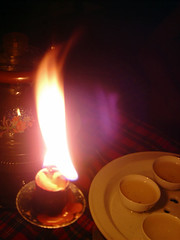Gongfu Tea
 On Saturday night I was called out by a friend to join him and two others to drink tea. This is one thing I really love about here, and apparently it doesn’t happen so much outside the Chaoshan area. The whole of Shantou, and I guess the Chaoshan area, is dotted with tea houses (茶馆). They’re usually on the second floor - maybe it’s quieter a bit higher up, or outside in tea gardens. And whereas people go out for a pint in England, they go out for tea in Shantou. (Alcohol is usually drunk at speed here.) In the national chains such as MingTian (名典) and ULC, there’s lots of wierd and wonderful teas and even coffees to have, but if you want genuine Chaoshan tea, you need to go to one that’s probably independent, or somewhere outside. (Although it’s also available in the chains.)
On Saturday night I was called out by a friend to join him and two others to drink tea. This is one thing I really love about here, and apparently it doesn’t happen so much outside the Chaoshan area. The whole of Shantou, and I guess the Chaoshan area, is dotted with tea houses (茶馆). They’re usually on the second floor - maybe it’s quieter a bit higher up, or outside in tea gardens. And whereas people go out for a pint in England, they go out for tea in Shantou. (Alcohol is usually drunk at speed here.) In the national chains such as MingTian (名典) and ULC, there’s lots of wierd and wonderful teas and even coffees to have, but if you want genuine Chaoshan tea, you need to go to one that’s probably independent, or somewhere outside. (Although it’s also available in the chains.)
The tea, or rather the way of making tea, is special to this area. It’s called ‘gongfu cha’ (功夫茶), which translates as kungfu tea, hehe. This is because it takes so much effort to make it! Well, I think so anyway, that’s what I was told. You have a round tea set with a round bowl with a lid which is the teapot. And there are always three cups. This is traditional, but also it’s because the teapot pours about three cup’s worth of tea. One cup is about one mouthful - if you have an asbestos mouth, because the tea must be boiling hot, preferably freshly boiled. Some older people here definately have asbestos mouths.
You pour boiling water into the cups and then (usually) pick them up with your hands and wash them inside each other one by one, may I add that asbestos finger tips are also handy here. I have been taught to hold the rims and move quickly so that it doesn’t hurt (ha, much). Boiling water is poured onto tea in pot, after a few seconds this is emptied out, THE FIRST POT CAN NEVER BE DRUNK. Aparently the tea must be washed first. Water added a second time, left for a bit, then poured. People drink, talk, and when the pourer feels like it, s/he will cleans the cups again and pour another round. Tea is usually some kind of oolong or black tea I think - not quite clear on this yet, I go for ‘tie guan yin’ (铁观音) always, because it’s popular and good - a Fujian tea.
The essence of tea drinking here is not to drink tea, although pouring tea is an art form. It is talking, and this I like very much.

